manolis
Aluminum
- Joined
- Nov 25, 2006
- Location
- Athens Greece
Here are the internal parts

of the PatOP opposed piston engine, presented in details at http://www.pattakon.com/pattakonPatOP.htm.
Bore: 79.5mm
Stroke: 64+64=128mm
Displacement: 635cc
Compression ratio: 17
Scavenging pump bore: 130mm (1.34 scavenging ratio)
Total engine height: 500mm
Total engine weight (without the flywheel): less than 20Kp
It is an:
opposed-piston,
two-stroke,
single-cylinder,
single-crankshaft,
full-balanced (vibration free),
cross-head,
direct-injection Diesel engine,
with built-in "volumetric" (for a wider rev range and flat torque curve) scavenging pump,
with four-stroke-like lubrication,
and with some 35% as compared to the conventional, or some 20% as compared to the Junkers-Doxford and to the OPOC of EcoMotors, additional time for the injection and combustion of the fuel.
See the videos of this prototype running on Diesel fuel.
Question:
With your experience, what is your rough estimation about the manufacturing cost for such an engine in small quantities (say 1 to 10 pieces) and in medium quantities (say 100 pieces)?
The "angles" of the bevel gears:

of a Portable Flyer (based on the OPRE engine at http://www.pattakon.com/pattakonOPRE.htm ) are quite small (say 5 degrees the smaller).
According the local "gear machinists", this machining is imposible.
Trying to make them in a "double head" EDM wire machine, the offered price (not to design, just to cut them) is unaffordable.
I know I can make "geometrically" correct bevel gears of this kind using a typical 4-axes CNC milling machine with a tapper end milling tool.
Any better idea?
Thanks
Manolis Pattakos

of the PatOP opposed piston engine, presented in details at http://www.pattakon.com/pattakonPatOP.htm.
Bore: 79.5mm
Stroke: 64+64=128mm
Displacement: 635cc
Compression ratio: 17
Scavenging pump bore: 130mm (1.34 scavenging ratio)
Total engine height: 500mm
Total engine weight (without the flywheel): less than 20Kp
It is an:
opposed-piston,
two-stroke,
single-cylinder,
single-crankshaft,
full-balanced (vibration free),
cross-head,
direct-injection Diesel engine,
with built-in "volumetric" (for a wider rev range and flat torque curve) scavenging pump,
with four-stroke-like lubrication,
and with some 35% as compared to the conventional, or some 20% as compared to the Junkers-Doxford and to the OPOC of EcoMotors, additional time for the injection and combustion of the fuel.
See the videos of this prototype running on Diesel fuel.
Question:
With your experience, what is your rough estimation about the manufacturing cost for such an engine in small quantities (say 1 to 10 pieces) and in medium quantities (say 100 pieces)?
The "angles" of the bevel gears:

of a Portable Flyer (based on the OPRE engine at http://www.pattakon.com/pattakonOPRE.htm ) are quite small (say 5 degrees the smaller).
According the local "gear machinists", this machining is imposible.
Trying to make them in a "double head" EDM wire machine, the offered price (not to design, just to cut them) is unaffordable.
I know I can make "geometrically" correct bevel gears of this kind using a typical 4-axes CNC milling machine with a tapper end milling tool.
Any better idea?
Thanks
Manolis Pattakos

















